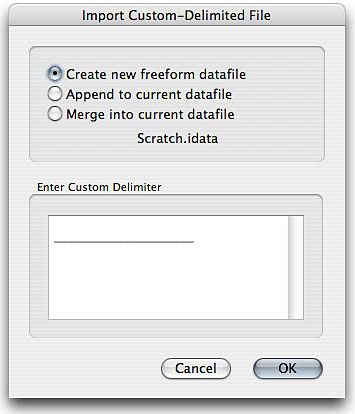Custom-delimited Basics
Custom-delimited files are text files that have records ending in a special string of characters of your choice. This means that you can open a text file in a text editor and break it up into records by typing or pasting the same group of characters wherever you wish to break the file up into records when it is imported.
The default delimiter, which always appears in the Import Custom-Delimited File dialog when it first opens, is a return followed by a line of 20 underscore characters, followed by two more returns. This is the divider that is inserted between records when iData Pro exports a datafile as a text file.
A particularly useful delimiter is the linefeed character, which can be inserted by typing the return key. If you have a text file with individual lines of text that you would like to move into the Freeform Text Area as separate records, using the linefeed character as a custom delimiter will do this for you. Note, however, that if you have a text file that was created on an older Macintosh system (pre-OS X) or a Windows machine, different end-of-line symbols may have been used. In this case, you should open your text file in a text editor and copy the end-of-line character(s), then paste them into the Enter Custom Delimiter text field, as explained below.
To import a custom-delimited file:
1. In the Finder, make sure that the text file to be imported has a .txt, .text, .rtf, or .rtfd file name extension. This is the only way iData Pro has of recognizing valid text files. (Note: However, you should not try to import files of other types by simply changing the file name extension. This will not work, and may cause iData Pro to crash.)
2. In iData Pro, select Custom-delimited File... from the Import menu under the File menu.
3. In the Open dialog that comes up next, navigate to your custom-delimited file, select it, and click the Open button.
4. The following dialog will appear. If there is no current datafile open, only the first option will be available. (Note: Although iData Pro will only create freeform datafiles from custom-delimited files, the imported data goes into the Freeform Text Area, so it is possible to import them into field-based datafiles, as well as into freeform datafiles.)

5. If applicable, select one of the radio buttons. Here are what the options mean:
a. Create new freeform datafile - As you might expect, this will create a new datafile containing the imported custom-delimited data. You will be able to save the new datafile with any name you desire.
b. Append to current datafile - If this option is available, it will cause newly imported records to be added at the end of the current datafile. If you are importing a later version of the custom-delimited file that was used to create the current datafile, you will probably end up with duplicate records.
c. Merge into current datafile - If this option is available, after adding the newly imported records, iData Pro will automatically remove all exact duplicates, so this is probably the best option for repeatedly updating a datafile for a particular custom-delimited file. Note that removing duplicates requires that the datafile be sorted by the contents of all the fields in order, so if you have rearranged the datafile for any reason, that order will be lost.
6. If you do not want to use the default delimiter, click in the Enter Custom Delimiter text field, type command-A to select all of the text, and either type or paste in your new delimiter. (Note: Since you can type the return key to enter the linefeed character in this field, therefore you must use command-return to activate the OK button. Also note that you can type the tab character in this field.)
7. Click the OK button to start the import.
8. Once the import is complete, if you selected the first option, the result will be a new untitled datafile. In this case, we recommend that you save the new datafile right away, giving it the same name as the file from which it was imported, but retaining the required .id3 file name extension.
Importing A Plain Text File
It is possible to import a plain text file into iData, treating each paragraph (line ending in a return) as a new record. By importing the file as a custom-delimited file, you can create a datafiel with the contents of each paragraph going into the Freeform Text Area of a separate record.
Preparing the Data
Since each return will be used to create a record, blank lines will create blank records. To avoid this, first open your text file in TextEdit and remove all blank lines.
Importing Paragraphs as Freeform Text
Import the file as a custom-delimited file, as described above, typing a single return into the Enter Custom Delimiter text field .